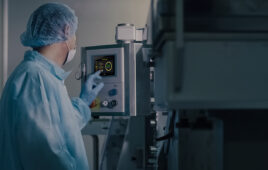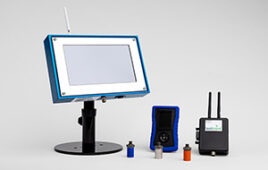By Ethan Taylor, Taylor Controls
When a grain blending company realized it was time to upgrade its aging controls originally developed in-house, it looked for just the right combination of PLC and HMI automation to advance its capabilities.

The new PLC/HMI panel incorporates the weighing instruments and provides a detailed graphical operator interface, which works with selector switches and magnetic product name tags to provide maximum flexibility.
The grain production company batches and blends ingredients to produce various livestock feed. Over the years, the operation applied equipment and electrical/electronic components to perform necessary tasks. However, changing from one formulation to the next required significant effort and sometimes even wiring modifications; this process raised additional concerns. Even though the company recognized the value of upgrading its systems, the team simply did not have the expertise or time to make the required changes.
For these reasons, the grain batcher connected with systems integrator Taylor Controls to provide them with the path forward.
A more complicated recipe
As the grain batcher’s clientele grew, there was an increasing call for more formulations and recipes. Coupled with a need to increase throughput and support more rapid changeovers between recipes, the existing semi-automated system was pushed to the brink and exhibited unexpected errors.
Using auger feeders, start-stop motor controls, and weigh cells, the existing system met production requirements in the past. But changing recipes was difficult, and because the ingredient types and weighments could vary so much between recipes, it was sometimes necessary to alter which component was added by a given feeder. Typically, this required a skilled electrical technician to make hardwired changes, which was time-consuming and unsupportable over the long term. As more wiring needed changing, and some starters required replacement, it became clear that a more flexible recipe system was a top priority.
Furthermore, the existing system did not have any self-learning provisions. Because the material behavior through a feeder could vary greatly depending on the type, quality, and moisture content of each component, the actual weighments fluctuated from target by an unacceptable amount, sometimes from batch to batch. The company desired a dynamic and responsive method to overcome this.
Each recipe ingredient needed to feed into a weight-scaled vessel, one at a time. The feeder would operate at a high “bulk” speed for as long as practical to improve throughput but would slow to a low “dribble” speed as the fill approached the setpoint to hit the target weight. Even at low speed, it would be important for the system to self-learn the free fall amount of product after the feeder stopped to account for varying conditions.

An AutomationDirect Productivity1000 PLC performs all operational calculations and controls, operating some equipment through wired I/O modules and commanding a DURAPulse GS20 VFD via EtherNet/IP.
One key change to support the flexibility required upgrading motor controls from simple starters to a VFD connected on a network with the host PLC using Ethernet to easily command any speed.

The enclosure, PLC, I/O, HMI, and most associated products—including power supplies and terminal blocks—were readily sourced from AutomationDirect, supporting a rapid design and installation.
The PLC/HMI platform needed to be capable of performing these tasks but accessible and easy to use so on-site technicians could maintain it to the greatest extent possible — close integration with the VFD was a must.
Implementing the solution
It was determined that a new control panel would house the PLC and HMI, while the VFD would be installed in a remotely located motor control panel. Furthermore, because only one material feeds at a time, it was determined that only a single oversized VFD would be used, and it would be connected to whichever motor was needed using contactors and coordinated overload protection.
This retrofit was also an opportunity to provide well-organized code, providing far better operational reliability than the old system. One main logic sequence is used, and each ingredient is “mapped” to this logic, so any future modifications only need to be performed in a single location. The code also takes advantage of user-defined structures (UDS) for creating custom-grouped sets of related tag data, making it easy and efficient to organize and use the type of data associated with each ingredient. The on-site staff has found this programming approach straightforward and convenient.
For interfacing the new automation with the user’s servers to provide production data, the MQTT Internet of Things (IoT) messaging protocol was used. MQTT provides an efficient and lightweight way for industrial devices to communicate with other systems, and it is natively supported within the Productivity PLC platform. The development team reviewed the comprehensive PLC documentation regarding MQTT and was easily able to configure this functionality.

A large 15-in. AutomationDirect C-more HMI provides plenty of graphical real estate, with many displays for (clockwise from top left): batching and mixing current status, dry ingredient auger free fall calculations, formula selection, and dry ingredient recipe configuration.
There are plenty of possible future expansion capabilities, and other advancements, such as remote monitoring and alarming, may be added for further production improvements.
Taylor Controls
taylor-controls.com
Filed Under: Displays • HMIs • operator interfaces • monitors




